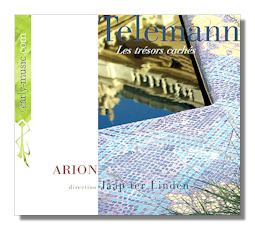
The Internet's Premier Classical Music Source
Related Links
- Telemann Reviews
- Latest Reviews
- More Reviews
-
By Composer
-
Collections
DVD & Blu-ray
Books
Concert Reviews
Articles/Interviews
Software
Audio
Search Amazon
Recommended Links
Site News
 CD Review
CD Review
Georg Philipp Telemann

Les trésors cachés
- Ouverture in D Major for 2 Oboes, 2 Violins, Recorder, Bassoon, Strings & Continuo, TWV 55:D4
- Concerto in D Major "Alla francese" for 2 Oboes, Bassoon, Strings & Continuo, TWV 55:C1
- Concerto in G Major for Flute, Strings & Continuo, TWV 51:G2
- Ouverture in C minor "L'Omphale" for Strings & Continuo, TWV 55:c8
- Ouverture in E Flat Major for 2 Horns, Strings & Continuo, TWV 55:Es1
Arion Baroque Ensemble/Jaap ter Linden
early-music.com EMCCD-7766 DDD 71:56
Arion is a Montréal-based ensemble formed in 1981. Its members perform on period instruments, and it has an active list of guest conductors, who include Jaap ter Linden. Ter Linden probably will be familiar to Baroque enthusiasts for his work on the cello and the gamba, but he has been devoting more time than ever to conducting – both period ensembles like Arion and modern orchestras too.
This collection is titled "Les trésors cachés," implying that the repertory is unfamiliar. I know that at least some of these works have been recorded previously, so how "hidden" these treasures (all of them currently available in modern editions) is open for discussion. That they are treasures is more difficult to dispute. Most of these works come from relatively early in Telemann's career. None of them requires an apology. Even in the second decade of the 1700s, when Telemann was in his thirties, he displayed uncommon curiosity about the musical world around him, and he added styles from all over Europe to his increasingly broad palette. Not even Bach showed as much appreciation for diversity, if you will, as Telemann did.
Bach was well acquainted with Telemann and his music, and the first movement of Telemann's Concerto in G for flute, strings, and continuo opens with a theme so suave and appealing that Bach apparently could not resist borrowing it (with modifications) for his Harpsichord Concerto in F minor, BWV 1056, and using it in the second movement. Don't call the copyright cops on Bach, though, since borrowing was a sincere and approved means of flattery during the Baroque era.
There's nothing scrawny about Arion's playing on this CD. I don't know if all of its musicians play in each work, but Arion's roll-call here includes five first violins, three second violins, two violas and cellos, one double bass, two recorders, one flute, two oboes, two horns, bassoon, and harpsichord. Also, no soloists are named in the booklet, so I assume that solo duties are taken on by the members themselves, as required. The playing throughout is stylish and imaginative, and it dances when it needs to, given Telemann's fondness for dance movements. The recording venue, a church in Québec, blurs the sonic perspective a little, but doesn't ruin it.
This CD is a fine addition to anyone's Telemann collection!
Copyright © 2009, Raymond Tuttle




















